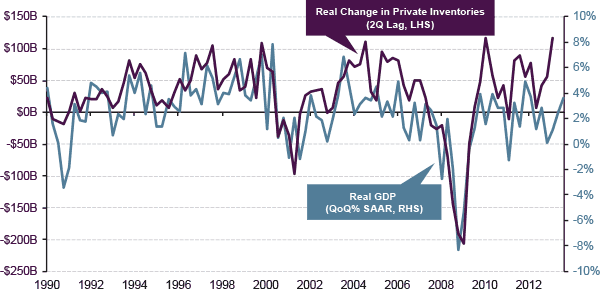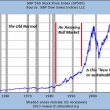December 11 2013
Financial markets have been discounting the end of tapering for months, and whether it happens in December or March is less important than the reality that the U.S. economy is recovering amid a global synchronous expansion.
Global CIO Commentary by Scott Minerd
Whether the Federal Reserve starts to shrink its asset purchase program now or waits until the first daffodils of spring is meaningless, in the grand scheme of things. As I wrote last week, we appear to be at the start of a global synchronous expansion – with everything from Chinese export data to ISI’s Christmas Tree Sales survey looking up. This has been and will likely continue to be good news for global equity markets, but what about the bond market?
I continue to believe that we are not headed back to the dark days of fixed-income investing in the 1970s, when yields increased by more than 10 percentage points between 1971 and 1981. Instead we are likely to live through a period similar to the 1940s, when investors had a decade of rate stability, with rates range-bound between 1.95 percent and 2.7 percent.
Although investors today have a much shorter fuse, the end of the Fed’s program of quantitative easing is not the same as raising rates. Nor is it the same as the Treasury Accord of 1951, when the Fed, exerting its independence, refused to keep rates pegged at a low rate after the start of the Korean War in 1950. Quite the opposite is likely to occur now. In conjunction with tapering, I believe that the Fed will likely strengthen its forward guidance and lower its unemployment target – pushing off a rate rise until after 2015.
Regardless of the Fed’s taper timing, the supply/demand dynamic for Treasuries is also shifting. At home, thanks to sequester and debt ceiling fights, the federal government is borrowing less. Overseas, international investors are looking anew at Treasuries. Japanese pensions, for example, are buying 10-year U.S. Treasury securities because the real return is highly attractive given the depreciation of the yen. Altogether, there are few if any visible obstacles to the improving investment outlook as we close out the year. Risk assets, and equities in particular, appear to have upside and 10-year Treasury yields will likely stay in a fairly narrow range, with an upper limit of about 3.5 percent.
Chart of the Week
Inventory Buildup Presents Downside Risk to Q4 GDP
Nearly half of third quarter real GDP growth came from the buildup of inventories. In real terms, the inventory increase was the largest in over 15 years. While this made the third quarter GDP figure appear strong on the surface, it presents a downside risk to fourth quarter GDP growth. Historically, changes in inventories tend to lag the growth rate of the overall economy, and the large inventory accumulation over the past two quarters is not supported by the rate of economic growth. This divergence suggests that there may be a significant slowing of inventory accumulation in the fourth quarter, and as a result, lower fourth quarter GDP growth.
CHANGE IN INVENTORIES AND REAL GDP GROWTH

Source: Haver Analytics, Guggenheim Investments. Data as of 3Q2013.
Economic Data Releases
U.S. Payrolls Overwhelmingly Positive
- Non-farm payrolls rose by 203,000 in November, above expectations. Along with other sectors, manufacturing and construction employment were strong.
- The unemployment rate dropped to 7.0% in November, the lowest in five years, even as the labor force participation rate rose.
- Average hourly earnings were up 0.2% in November and the workweek rose to 34.5 hours.
- Initial jobless claims dropped to 298,000 for the week ended November 30th, the lowest since September 6th.
- Third quarter GDP growth was revised up a second time, to 3.6%. However, the gain was due to inventory buildup, which contributed 1.7 percentage points.
- University of Michigan consumer confidence jumped to 82.5 in December from 75.1 in November, the highest since July.
- The NFIB Small Business Optimism Index improved to 92.5 in November, the first increase since July.
- Personal income unexpectedly fell in October, down 0.1% in the first decrease since January 2013.
German Data Falters, China’s Exports Jump
- German industrial production unexpectedly fell for a second consecutive month in October, down 1.2%.
- German exports inched up 0.2% in October, the third straight monthly gain.
- German factory orders dropped 2.2% in October, which was the most this year.
- French industrial production fell for a second consecutive month in October, down 0.3%.
- Industrial production in the U.K. increased 0.4% in October after a 0.9% gain in September.
- China’s exports grew much more-than-expected in November, rising 12.7% year-over-year in November, the highest since April.
- Industrial production in China was just under expectations in November at 10.0% year-over-year, the slowest pace since July.
- China’s retail sales growth accelerated to 13.7% in November, the highest this year.
- Fixed-asset investment in China slowed to 19.9% year-over-year in November, the lowest since 2002.
- Japan’s economy watchers economic outlook survey rose to 54.8 in November, the third consecutive increase.














